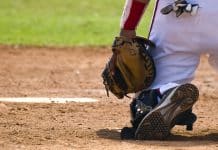Have you ever wondered how to break in new baseball cleats? Well, look no further because we have got you covered! In this article, we will share some tried and tested tips on how to properly break in your new baseball cleats, ensuring maximum comfort and performance on the field. So, if you’re tired of dealing with painful blisters and uncomfortable cleats, keep reading to discover our helpful suggestions.
This image is property of baseballscouter.com.
Choosing the Right Baseball Cleats
When it comes to choosing the right baseball cleats, there are a few factors to consider. One of the most important factors is the field surface. Different types of surfaces require different types of cleats for optimal performance. For example, if you’re playing on a grass field, metal cleats may provide excellent traction. However, if you’re playing on a turf field, molded cleats or turf shoes might be a better option to avoid damaging the surface.
Another consideration when selecting baseball cleats is the type of cleats themselves. There are three main types of cleats: metal, molded, and turf. Metal cleats, as mentioned earlier, are great for traction on grass fields but are typically not allowed in youth leagues. Molded cleats, on the other hand, are suitable for most field types and are generally more comfortable. Lastly, turf shoes are designed specifically for artificial turf surfaces and provide excellent grip without damaging the field.
Lastly, ensuring proper fit and comfort is crucial when choosing baseball cleats. Ill-fitting cleats can cause discomfort and even lead to foot injuries. It’s important to try on different sizes and styles to find the one that fits your foot shape and size best. Additionally, considering factors such as arch support, cushioning, and ankle stability will contribute to overall comfort while wearing the cleats.
Preparing the Cleats for Break-in
Before breaking in your new baseball cleats, it’s essential to prepare them properly. This involves inspecting the cleats, cleaning them, applying leather softener, and wearing thick socks during the break-in process.
Inspecting the cleats is crucial to ensure there are no manufacturing defects or damage that could affect their performance or your comfort. Check the stitching, laces, and overall construction of the cleats to ensure they are in good condition.
Cleaning the cleats is another essential step before breaking them in. Remove any dirt, mud, or debris from the cleats using a brush or cloth. Cleaning the cleats not only helps maintain their appearance but also ensures there are no particles that could cause discomfort during the break-in process.
To soften the leather and make it more pliable, apply a leather softener specifically designed for athletic shoes. This will help prevent blisters and allow the cleats to mold to your feet better.
During the break-in process, it’s recommended to wear thick socks to provide additional padding and protection. Thick socks can help prevent blisters and cushion your feet, especially during the initial stages of breaking in the cleats.
Breaking In Baseball Cleats
Breaking in baseball cleats is a process that requires time and patience. It’s important to gradually increase usage time and engage in specific exercises and activities to properly break in the cleats.
Start with short practice sessions, wearing the cleats for a limited amount of time. This allows your feet to get accustomed to the cleats without subjecting them to excessive strain. Over time, gradually increase the duration of your practice sessions until you can wear the cleats comfortably for a full game.
While wearing the cleats, perform light jogging to help flex and stretch the materials. This will aid in the break-in process and allow the cleats to mold to your feet more naturally.
Practice athletic movements that are specific to your position in baseball. This can include running, jumping, pivoting, and quick directional changes. These movements simulate the actions you’ll be performing during games and help the cleats adapt to the way you move on the field.
Make quick directional changes, such as shifting your weight from side to side or pivoting on one foot. These movements put additional stress on the cleats and help them adapt to your foot’s motion.
Walking and flexing your feet while wearing the cleats can also help break them in. By repeatedly bending your feet and toes while walking, you’re allowing the materials to loosen up and fit more comfortably around your feet.
Using baseball pitching machines can be a useful tool for breaking in cleats. As the machine propels the balls towards you, it requires quick reactions and movements, helping break in the cleats in a game-like scenario.
Engaging in controlled games, such as scrimmages or practice matches, can provide a more realistic environment to break in your cleats. This allows you to experience different game situations while wearing the cleats, helping them adapt to your movements on the field.
It’s important to note that during the break-in process, baseball cleats should only be worn on the field. Wearing them off the field, especially on hard surfaces like concrete, can cause unnecessary wear and tear and affect their performance.
Maintaining and Extending Cleat Lifespan
Proper maintenance is essential to not only extend the lifespan of your baseball cleats but also ensure optimal performance throughout their lifespan. Cleaning the cleats after each use, storing them in a dry and ventilated area, avoiding extreme temperatures, and replacing worn-out cleats are all important factors in maintaining cleat quality.
Cleaning the cleats after each use helps remove any dirt, mud, or debris that could accumulate on the outsole or get lodged between the cleats. Use a brush or cloth to wipe away any residue and keep the cleats clean and ready for the next use.
Storing the cleats in a dry and ventilated area is crucial to prevent moisture buildup and odor. Avoid leaving them in damp places or closed containers, as this can lead to the growth of bacteria or mold. Providing sufficient air circulation will help keep the cleats dry and fresh.
Extreme temperatures can have a negative impact on the materials of the cleats. Avoid exposing them to direct sunlight or extreme heat, as this can cause the materials to warp or deteriorate. Similarly, extreme cold temperatures can make the materials brittle and prone to cracking. Keeping the cleats in a moderate temperature environment will help maintain their integrity.
As with any athletic shoes, baseball cleats will eventually wear out and lose their effectiveness. Inspect the cleats regularly and look for signs of excessive wear on the outsole, loss of traction, or damage to the upper. If you notice any of these signs or experience persistent discomfort or pain while wearing the cleats, it’s time to replace them to ensure your safety and performance on the field.
This image is property of littleballparks.com.
Dealing with Discomfort and Common Issues
During the break-in process, it’s not uncommon to experience discomfort or encounter common issues such as hot spots, blisters, foot pain, or tightness. Here are some tips to address and alleviate these problems:
Hot spots, which are areas of irritation or rubbing on the feet, can often be relieved by applying moleskin or athletic tape to the affected areas. These padding materials act as a barrier between your skin and the cleats, reducing friction and preventing further irritation.
If blisters occur, it’s important to treat them properly to prevent infection and promote healing. Clean the affected area with mild soap and water, apply an antibacterial ointment, and cover the blister with a sterile bandage. Avoid popping the blister, as this can increase the risk of infection.
Foot pain can have various causes, such as improper fit, lack of cushioning, or arch support. Using gel inserts or custom orthotics can provide additional cushioning and support to alleviate foot pain. Additionally, taking breaks during practice or games and stretching your feet can help relieve pain and discomfort.
If the cleats feel too tight, there are several methods to address the issue. Using double socks can create additional padding and provide a bit of extra space inside the cleats. Alternatively, using a shoe stretcher or applying heat with a hairdryer to stretch the materials can also help alleviate tightness.
Applying petroleum jelly to areas where the cleats rub against your skin can help reduce friction and prevent blisters or hot spots. Apply a thin layer of petroleum jelly to the affected areas before wearing the cleats.
If you’re still struggling with breaking in your cleats or experiencing significant discomfort, consider seeking professional help from a podiatrist or sports medicine specialist. They can provide personalized advice and recommend specific solutions based on your needs.
Tips and Tricks for Breaking In Cleats
In addition to the steps and methods mentioned above, here are a few additional tips and tricks to help facilitate the break-in process for your baseball cleats:
Using double socks can provide extra cushioning and alleviate discomfort caused by tight or new cleats. By wearing two pairs of socks, you create an additional layer of padding and help prevent blisters.
Using a shoe stretcher can be an effective way to stretch out tight areas of the cleats. Insert the shoe stretcher into the cleats and adjust it to gradually expand the materials in specific areas where you feel tightness or discomfort.
Applying heat with a hairdryer can loosen the materials and make them more pliable. Use the hairdryer on a low heat setting and apply it to the areas of the cleats that require stretching or softening. Be cautious not to overheat or damage the materials.
Massaging the cleats with your hands can help break them in and mold them to your feet. Apply gentle pressure and knead the materials to soften them. This can also help identify any areas that may require additional stretching or adjustment.
Applying petroleum jelly to the areas where the cleats rub against your skin can help reduce friction and prevent blisters. Apply a small amount of petroleum jelly to the affected areas before wearing the cleats.
If you’re having trouble stretching out tight areas of the cleats, consider utilizing cleat stretching tools specifically designed for this purpose. These tools apply even pressure and help expand the materials without causing damage.
Wearing cleat inserts or orthotic inserts can provide additional cushioning and support, especially if you have specific foot conditions or require extra arch support. These inserts can be easily inserted into the cleats and help customize the fit and comfort.
This image is property of www.baseballbible.net.
Potential Risks and Precautions
While breaking in baseball cleats, it’s important to be mindful of potential risks and take necessary precautions to avoid injury or discomfort. Here are a few important considerations:
Avoid overstretching or overheating the cleats. Applying excessive force, heat, or stretching techniques can damage the materials or alter the fit of the cleats in an unfavorable way. Follow manufacturer guidelines and use caution when using stretching methods.
Don’t use excessive force when breaking in the cleats. While it’s important to engage in athletic movements and put some stress on the cleats, using excessive force can lead to premature wear or even breakage. Maintain a reasonable level of intensity during the break-in process.
Take breaks and listen to your feet. If you experience persistent pain or discomfort, it’s important to take breaks and allow your feet to rest. Pushing through pain can lead to more severe injuries or prolonged discomfort.
Monitor for any allergic reactions. Some individuals may have allergies to certain materials used in the construction of baseball cleats. If you experience persistent redness, itching, or swelling, discontinue use immediately and seek medical attention.
Factors Affecting Break-in Time
The time required to break in baseball cleats can vary based on several factors. Understanding these factors can help manage expectations and adapt the break-in process accordingly. Here are a few factors that can affect the break-in time:
The quality of the cleats significantly impacts the break-in time. High-quality cleats made from durable materials may require longer to break in compared to lower-quality cleats. However, quality cleats typically offer better performance and longevity.
The material of the cleats can also influence the break-in time. Leather cleats tend to require a longer break-in period compared to synthetic materials. Leather is more rigid initially but becomes more pliable and molds to the foot over time.
The frequency and intensity of use affect the break-in time as well. Regular use and engaging in intense athletic movements will help break in the cleats faster compared to occasional use or less physically demanding activities.
Individual differences in foot shape and size can impact the break-in time. Everyone’s feet are unique, and it may take longer for some individuals to achieve a comfortable fit with their baseball cleats. Factors such as arch type, foot width, and specific foot conditions can influence the break-in process.
This image is property of littleballparks.com.
When to Replace Baseball Cleats
Despite proper maintenance and care, baseball cleats will eventually wear out and need to be replaced. Here are a few signs that indicate it’s time to replace your baseball cleats:
Excessive wear on the outsole is a clear sign that the cleats have reached the end of their lifespan. If the cleats no longer provide adequate traction or the outsole is significantly worn down, it’s time to consider replacing them.
Loss of traction can severely impact your performance and safety on the field. If you find that your cleats are slipping or not gripping the field as they used to, it’s a strong indication that they should be replaced.
Damaged or separated upper, such as torn stitching or detached sections, can compromise the structural integrity of the cleats. If you notice any significant damage to the upper that cannot be repaired, it’s time to invest in new cleats.
Persistent discomfort or pain while wearing the cleats is a sign that they are no longer providing the necessary support or fit. If you’ve tried various methods to break them in and still experience discomfort, it’s time to consider replacing them to prevent further injuries.
Conclusion
Choosing the right baseball cleats, properly preparing them for break-in, and applying effective strategies to break them in are crucial steps to ensure optimal performance and comfort on the field. By considering the field surface, selecting the appropriate cleat type, and ensuring proper fit and comfort, you lay the foundation for a successful break-in process. Following the steps for inspecting, cleaning, and softening the cleats, as well as gradually increasing usage time and engaging in specific exercises, will help mold the cleats to your feet.
Maintaining the cleats, addressing discomfort and common issues, and implementing helpful tips and tricks can further enhance your experience with the cleats. Understanding potential risks, paying attention to break-in time factors, and knowing when to replace the cleats are all essential aspects of properly managing and maximizing the lifespan of your baseball cleats. With the right approach, breaking in new baseball cleats can be a rewarding process that ultimately enhances your performance on the field.
This image is property of littleballparks.com.










































